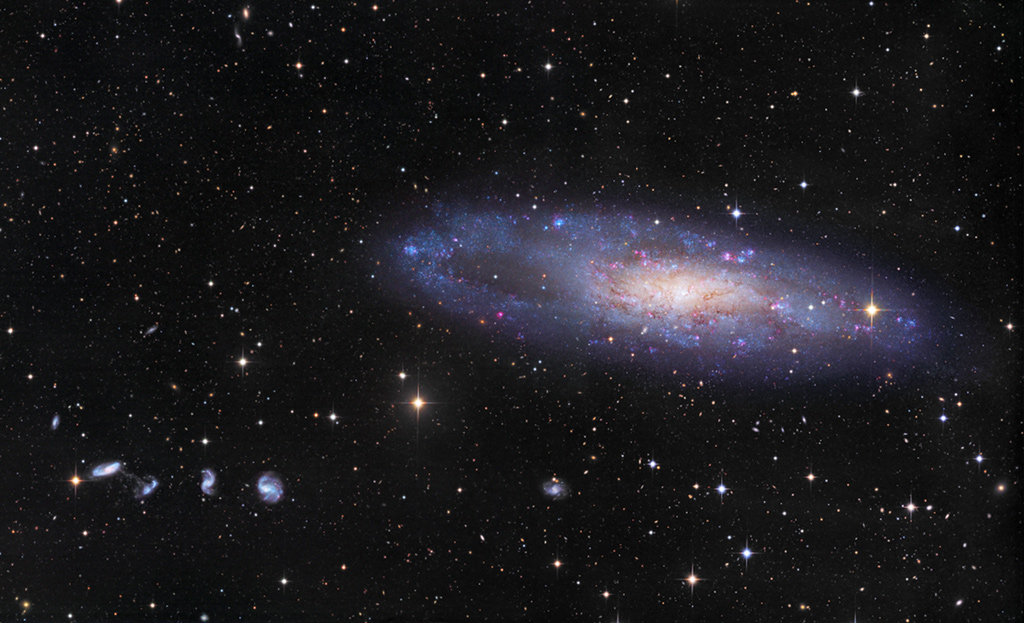https://en.wikipedia.org/wiki/H_II_region wrote:
https://apod.nasa.gov/apod/ap171116.html
<<An H II region or HII region is a region of interstellar atomic hydrogen that is ionized. It is typically a cloud of partially ionized gas in which star formation has recently taken place, with a size ranging from one to hundreds of light years, and density from a few to about a million particles per cubic cm. The Orion Nebula, now known to be an H II region, was observed in 1610 by Nicolas-Claude Fabri de Peiresc by telescope, the first such object discovered. Chemically, H II regions consist of about 90% hydrogen. The strongest hydrogen emission line at 656.3 nm gives H II regions their characteristic red colour. Most of the rest of an H II region consists of helium, with trace amounts of heavier elements. Across the galaxy, it is found that the amount of heavy elements in H II regions decreases with increasing distance from the galactic centre. This is because over the lifetime of the galaxy, star formation rates have been greater in the denser central regions, resulting in greater enrichment of those regions of the interstellar medium with the products of nucleosynthesis.
The term H II is pronounced "H two" by astronomers [as opposed to say: "
two Corinthians" said by some Presidents]. It is customary in astronomy to use the Roman numeral I for neutral atoms, II for singly-ionised—H II is H+ in other sciences—III for doubly-ionised, e.g. O III is O++, etc. H II, or H+, consists of free protons. An H I region being neutral atomic hydrogen, and a molecular cloud being molecular hydrogen, H2.
H II regions may be of any shape, because the distribution of the stars and gas inside them is irregular. The short-lived blue stars created in these regions emit copious amounts of ultraviolet light that ionize the surrounding gas. H II regions—sometimes several hundred light-years across—are often associated with giant molecular clouds. They often appear clumpy and filamentary, sometimes showing bizarre shapes such as the Horsehead Nebula. H II regions may give birth to thousands of stars over a period of several million years. In the end, supernova explosions and strong stellar winds from the most massive stars in the resulting star cluster will disperse the gases of the H II region, leaving behind a cluster of stars which have formed, such as the Pleiades.
H II regions can be observed at considerable distances in the universe, and the study of extragalactic H II regions is important in determining the distance and chemical composition of galaxies. Spiral and irregular galaxies contain many H II regions, while elliptical galaxies are almost devoid of them. In spiral galaxies, including our Milky Way, H II regions are concentrated in the spiral arms, while in irregular galaxies they are distributed chaotically. Some galaxies contain huge H II regions, which may contain tens of thousands of stars. Examples include the 30 Doradus region in the Large Magellanic Cloud and NGC 604 in the Triangulum Galaxy.
A few of the brightest H II regions are visible to the naked eye. However, none seem to have been noticed before the advent of the telescope in the early 17th century. Even Galileo did not notice the Orion Nebula when he first observed the star cluster within it (previously cataloged as a single star, θ Orionis, by Johann Bayer). The French observer Nicolas-Claude Fabri de Peiresc is credited with the discovery of the Orion Nebula in 1610. Since that early observation large numbers of H II regions have been discovered in the Milky Way and other galaxies.
William Herschel observed the Orion Nebula in 1774, and described it later as "an unformed fiery mist, the chaotic material of future suns". In early days astronomers distinguished between "diffuse nebulae" (now known to be H II regions), which retained their fuzzy appearance under magnification through a large telescope, and nebulae that could be resolved into stars, now know to be galaxies external to our own.
The precursor to an H II region is a giant molecular cloud (GMC). A GMC is a cold (10–20 K) and dense cloud consisting mostly of molecular hydrogen. GMCs can exist in a stable state for long periods of time, but shock waves due to supernovae, collisions between clouds, and magnetic interactions can trigger its collapse. When this happens, via a process of collapse and fragmentation of the cloud, stars are born (see stellar evolution for a lengthier description).
As stars are born within a GMC, the most massive will reach temperatures hot enough to ionise the surrounding gas. Soon after the formation of an ionising radiation field, energetic photons create an ionisation front, which sweeps through the surrounding gas at supersonic speeds. At greater and greater distances from the ionising star, the ionisation front slows, while the pressure of the newly ionised gas causes the ionised volume to expand. Eventually, the ionisation front slows to subsonic speeds, and is overtaken by the shock front caused by the expansion of the material ejected from the nebula. The H II region has been born.
The lifetime of an H II region is of the order of a few million years. Radiation pressure from the hot young stars will eventually drive most of the gas away. In fact, the whole process tends to be very inefficient, with less than 10 percent of the gas in the H II region forming into stars before the rest is blown off. Contributing to the loss of gas are the supernova explosions of the most massive stars, which will occur after only 1–2 million years. The full details of massive star formation within H II regions are not yet well known. Two major problems hamper research in this area. First, the distance from Earth to large H II regions is considerable, with the nearest H II (California Nebula) region at 300 pc (1,000 light-years); other H II regions are several times that distance from Earth. Secondly, the formation of these stars is deeply obscured by dust, and visible light observations are impossible. Radio and infrared light can penetrate the dust, but the youngest stars may not emit much light at these wavelengths.>>
 NGC 247 and Friends
NGC 247 and Friends


